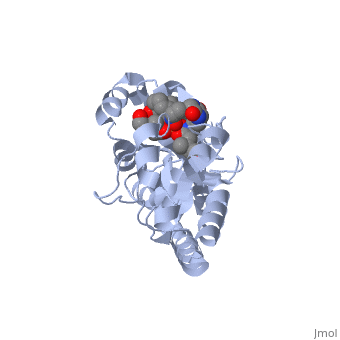FhuD
From Proteopedia
Contents |
PERIPLASMIC FERRIC SIDEROPHORE BINDING PROTEIN FHUD COMPLEXED WITH ALBOMYCIN (1esz)
|
OVERVIEW
Siderophore-binding proteins can be found in both Gram-positive and Gram-negative bacteria in divisions: hydroxamates, catecholates, and carboxylates.[1] In Escherichia coli. (E. coli) the ATP-binding cassette- type (ABC-type) protein FhuD (part of the helical backbone metal receptor superfamily) is a common periplasmic protein which facilitates the transport of a variety of hydoxamate siderophores to the inner membrane-associated proteins FhuB and FhuC.[1] The structure of FhuD is atypical for periplasmic ligand binding protein due to its bilobal mixture of two α/β domains connected by long α-helix.[1],[2]
PROTEIN STRUCTURE
FhuD structure is atypical for periplasmic ligand binding proteins. It is 266 residues in length containing a secondary structure composed of 41% helical (13 helices; 110 residues) and 17% beta sheet (13 strands; 47 residues).[1] It is a bilobal kidney bean shape with approximate dimensions 60 x 30 x 40 angstrom containing two domains which are connected by a 23-residue kinked alpha-helix.[1],[2] The (residues 27-141) twisted fived-stranded parallel beta-sheet with 3-2-1-4-5 linking topology whereas the C-terminal domain (residues 166-288) has a mixed five stranded β-sheet 3-2-1-4-5 linking topology; both are enclosed by alpha-helices. Between the two domains lies the shallow siderophore approximate 10 Angstrom deep which forms depression or "pocket."[1],[2] This pocket is lined with hydrophobic residues which side chain residues are able to create stabilizing hydrogen bonds with the accepted siderophore.[1] This is large enough to accommodate the hydrophobic orinthyl linkers of the siderophore.[1] Through rearrangements of the residues of the binding pocket and interactions with the iron-hydroxamate centers of the siderophore, recognition can occur with structurally diverse siderophores.[1] The binding diversity is further increased since the siderophore backbones do not interact with the proteins.[1] The structure of the binding pocket of FhuD allows molecules like coprogen bound to a siderophore to form several important hydrogen bonds to create a stable interaction for transportation. A hydrogen bond is formed between the hydroxamate oxygen opposite to the diketopiperazine ring and the terminal amine of Arg-84.[1] The other hydroxamate oxygen forms a hydrogen bond with the hydroxyl group of Tyr-106.[1] These hydrogen bonds are found in the iron coordinating components of the siderophore. This is similiar to Alboymcin which forms three protein-ligand hydrogen bonds between Arg-84 and Tyr-106.[1] Two between the terminal amino groups of Arg-84 and the hydroxamate siderophore and another between the remaining hydroxamate to the hydroxyl group of Tyr-106.[1] Slight movement of interactions between these residues are significant to FhuD`s ability to produce binding specificity and correct fit.[1]
PROTEIN FUNCTION
Siderophores function within both gram-positive and gram-negative bacteria to aid in the uptake of iron. They are low molecular weight (500-1000 Da) and can bind with association constraints as high as ten to the power of 50.[2] Let us consider E. coli which produces one siderophore called enterobactin yet can still use many siderophores including hydroxamate type, catecholates type, and citrate.[2] These siderophores require assisted entrance into bacterial cells through uptake systems. In gram negative bacteria, including E. coli, an ATP binding cassette type (ABC) is used which requires several proteins including an outer membrane receptor, periplasmic transport protein and inner membrane proteins.[1] When considering the hydroxamate type siderophore receptors of E.coli, specific outer membrane siderophore binding proteins are used such as FhuA for ferrichrome.[1] After transport in the periplasm, the periplasmic binding protein FhuD is required for the movement of all hydroxamate type siderophores to the cytoplasm and inner membrane proteins FhuB and FhuC.[1] This system allows for distribution of iron to the cell as required by the bacterium.
INTERESTING FACTS
Unlike other periplasmic ligand binding protein (PLBP), FhuD does not have the characteristic fold of a bilobate domain connected by flexible β-strands at the base of the ligand binding pocket.[1] This results in FhuD adopting a novel PLBP structure.[1] As designated by its structure, FhuD binds hydroxamate siderophores into a primarily hydrophobic pocket allowing the assumption that both binding and release do not cause large scale opening/closing.[2] However in the binding pocket, several major ligand binding side chains have been noted in various positions depending on the ligand bound.[1],[2] Due to the ability of siderophore binding uptake systems to allow such a diverse array of siderophore bound molecules, new bacterial growth inhibiting agents may be developed.[1] These agents will be delivered into the bacteria as silent “Trojan Horses” by the bacteria’s own uptake system.[1]
3D structures of FhuD
Ferric hydroxamate uptake receptor.
REFERENCES
- ↑ 1.00 1.01 1.02 1.03 1.04 1.05 1.06 1.07 1.08 1.09 1.10 1.11 1.12 1.13 1.14 1.15 1.16 1.17 1.18 1.19 1.20 1.21 1.22 Clarke TE, Braun V, Winkelmann G, Tari LW, Vogel HJ. X-ray crystallographic structures of the Escherichia coli periplasmic protein FhuD bound to hydroxamate-type siderophores and the antibiotic albomycin. J Biol Chem. 2002 Apr 19;277(16):13966-72. Epub 2002 Jan 22. PMID:11805094 doi:10.1074/jbc.M109385200
- ↑ 2.0 2.1 2.2 2.3 2.4 2.5 2.6 Clarke TE, Ku SY, Dougan DR, Vogel HJ, Tari LW. The structure of the ferric siderophore binding protein FhuD complexed with gallichrome. Nat Struct Biol. 2000 Apr;7(4):287-91. PMID:10742172 doi:10.1038/74048
Leni Rose 04:57, 13 March 2010 (IST)
Proteopedia Page Contributors and Editors (what is this?)
Leni Rose, Michal Harel, Alexander Berchansky, David Canner, William Eisbrenner, Andrea Gorrell

